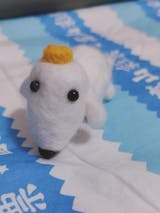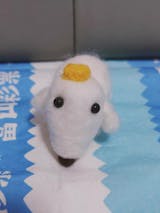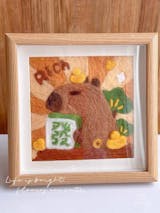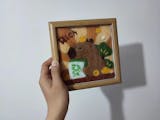
Best Wool for Needle Felting: A Complete Guide to Choosing the Best Fibers
Share
When I first started needle felting, I noticed that some felted figures looked smooth while others appeared fuzzy or uneven. It made me wonder—why are the results so different? So I began digging into books, studying materials, and even purchasing work from other studios to compare techniques and fibers. After countless tests, I finally identified the wool combination that works best for Joypok’s felted characters: a blend of Australian Queensland wool and fine Merino. In this guide, I’ll walk you through the different types of wool and the key differences between short and long fibers.
Wool types:
Needle-felting wool varies widely by breed, fiber length, and micron count, and each type behaves differently under the needle. Knowing these differences helps beginners choose fibers that shape well, felt quickly, or create smooth finishes.
Merino wool is one of the most commonly praised fibers in textile and felting guides. Its very fine, low-micron fibers make it exceptionally soft and smooth—ideal for clean surface finishes and detailed color work.
Medium-fiber breeds like Corriedale are often recommended for beginners. Their natural crimp and elasticity help fibers interlock fast, making them great for building firm 3D shapes.
Longwool breeds such as Romney and Blue-Faced Leicester (BFL) are noted for their long, durable fibers that add strength or create textured, wavy effects.
Regional wools like Queensland wool offer a balanced, versatile option. Its medium-to-long fibers and elasticity make shaping easier, while some finer “70s” grades or Corriedale-cross variations provide both softness and structure.
Other breeds—Shetland, Jacob, Icelandic—appear in wool guides for their unique textures and mixed fiber characteristics.
Across these categories, two fibers consistently stand out for needle felting:
- Merino, for refined, smooth, detailed surface work
- Queensland wool, for its elasticity, easy shaping, and versatile fiber length
Understanding these wool types helps felters choose the best material for structure, detailing, and polished final results.
Wool Preps Needle Felters Use:

1. Locks: Washed but unprocessed wool in its natural form—curly, wavy, or straight. Great for adding texture.
2. Core Wool: Short-fiber, quickly felting wool used for building internal structure. Usually undyed; sold as batts or roving.
3. Batt / Carded Wool: Fibers brushed into a soft, multi-directional sheet. Ideal for large shapes and general sculpting.
4. Roving: Loosely carded wool in a long rope-like strip. Common for wrapping shapes and everyday felting.
5. Sliver: A thinner version of roving, offering more control for finer wrapping and surface work.
6. Combed Top: Fibers aligned in one direction—long, smooth, and hair-like. Perfect for clean outer layers and color detailing.
7. Prefelt: A partially felted sheet that tears with feathery edges. Useful for appliqué and layered designs.
8. Felt Sheet: Fully felted, dense, smooth fabric. Must be cut; used for firm components and structured details.
Short Fibers vs. Long Fibers in Needle Felting:
Wool fibers differ by staple length, which changes how they behave in needle felting. According to felting guides, longer fibers—such as those found in Romney, BFL, and some Queensland wools—have more structural strength and elasticity. This makes them excellent for building internal shapes, wrapping forms, and creating a stable base.
Short fibers, often seen in finer breeds like Merino, compress quickly and lay down smoothly. Their soft, low-micron structure makes them ideal for outer layers, clean finishes, and detailed surface work.
Because of this natural divide, many felters use long fibers inside and short fibers outside to achieve both firmness and a polished appearance.
👉 Tip: Tear wool into smaller pieces—break fiber bundles down by 70% or more—before felting for smoother, more even results.

Why Joypok Uses Queensland Wool and Merino
After testing many wool types and comparing work from different studios, we found the most reliable combination for creating clean, well-shaped felted characters: Queensland wool + Merino wool.
Queensland wool provides a strong, elastic core that shapes easily and stays firm.
Merino wool offers fine, soft fibers that create smooth outer layers and detailed finishes.
Together, they give every Joypok project the ideal balance—stable on the inside, smooth on the outside—helping beginners achieve polished, charming results with confidence.






